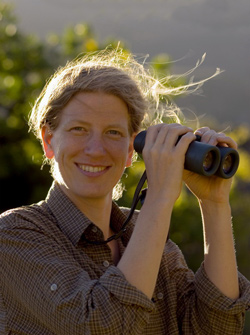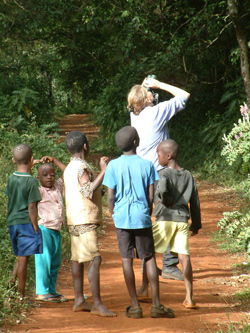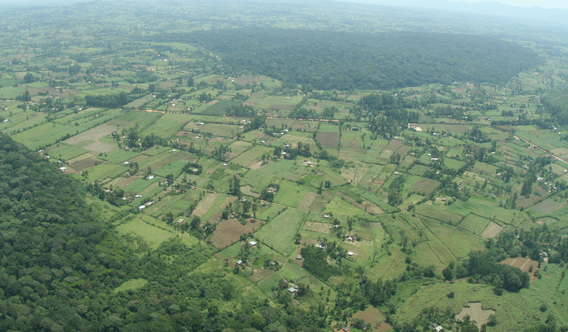Biodiversity conservation will only work if local people benefit
Biodiversity conservation will only work if local people benefit
An interview with Dr. Nina Farwig of BIOTA-East Africa
Rhett A. Butler, mongabay.com
November 19, 2007
Biodiversity loss is already having an economic impact in Africa according to a 7-year monitoring project underwritten by Europeans and African governments. The project, known as the Biodiversity Monitoring Transect Analysis in Africa (BIOTA), relies on a network of biodiversity observatories equipped with weather stations, sensors and a monitoring program that includes remote sensing, data on soil fertility and agricultural indicators.
To date the researchers have observed a series of consequences resulting from biodiversity loss, including a reduction of agricultural production potential, degradation of vegetation cover and of soil fertility, invasion of exotic species, decline of stabilizing ecosystem functions, an increase of fires, depletion of groundwater levels and increases in new infectious diseases and other health risks.
 Dr. Nina Farwig |
Dr. Nina Farwig, a scientist at the Johannes Gutenberg-University of Mainz and a participating member of BIOTA-East Africa, says that conservation efforts in the tropics will only be effective if the local people benefit. Her work with BIOTA shows that even in the absence of extensive forest cover, a patchwork of agricultural landscapes can contribute to the biodiversity conservation.
Dr. Farwig will be exploring the relationship between agriculture and biodiversity by organizing a symposium with the title: “Mobile links: pollination and seed dispersal in peril” at the June 2008 annual meeting for the Association for Tropical Biology and Conservation (ATBC) in Suriname. ATBC is a group of 1500 scientists in over 70 countries.
In a November interview with mongabay.com, Dr. Farwig explained her work and its significance in conservation.
AN INTERVIEW WITH DR. NINA FARWIG
Mongabay: What is your primary area of research?
Farwig: I am an ecologist and my main interests are within biodiversity research. I am particularly interested in the relationship between species richness and ecosystem processes i.e. will the loss of single species be compensated by others or will there be disruptions of ecological processes such as pollination or seed dispersal.
Mongabay: How did you become interested in biodiversity research?
 Children observing research activities of Dr. Farwig |
Farwig: My interest for biodiversity research in the tropics developed during several internships in research projects abroad. I was fascinated by the diversity of tropical forests. As a consequence I did my Masters in Madagascar working on the pollination ecology of a tropical tree and my PhD in Kenya working again with a tropical tree but this time studying the impact of forest fragmentation and disturbance on seed dispersal, seed predation and genetic diversity. My recent studies focused on regeneration potential of plantations and agricultural landscapes in particular how can these human-shaped landscapes contribute to conservation of biodiversity.
Mongabay: How can plantations and agricultural landscapes contribute to biodiversity conservation?
Farwig: Preliminary data of different types of forest plantations show as expected a clear difference in tree community but unexpectedly no difference in the overall diversity of birds. However, the community composition in plantations is highly dominated by forest visitor species. Seedling species richness in plantations was quite diverse suggesting that plantations and secondary forests could play a major role for natural forest regeneration.
Regarding the potential of agricultural landscapes to contribute to conservation of biodiversity, our data suggest that habitat heterogeneity in the cultivated land is of major significance for conservation of biodiversity. For instance remnant indigenous but also exotic fruiting trees attract many frugivorous birds and thus represent foci of seed rain and seedling establishment which might improve natural forest regeneration in the agricultural matrix.
 Cultivated lands near the fragment Kisere Forest in Western Kenya |
Mongabay: What are the biggest threats to the forests of East Africa?
Farwig: The fast population growth is the biggest threat to the remaining rainforests in East Africa as this leads to increasing demand for wood. Therefore, the aim of the interdisciplinary research project BIOTA Africa (www.biota-africa.org) is to develop management recommendations for sustainable use of tropical forests by considering not only ecological but also socio-economic aspects.
Mongabay: What’s the best way to conserve biodiversity?
 Sunrise over Kakamega forest in Western Kenya |
Farwig: I don’t know whether there is only one best way but I think it is only possible to protect tropical ecosystems if the local people benefit.
Mongabay: What can the general public do to help?
Farwig: Creating awareness for biodiversity and all its functions for ecosystems and human well-being.
Mongabay: What’s the best way to motivate young students to become interested in conservation science?
Farwig: Participating in a research project dealing with conservation science is a very good way to motivate young students.